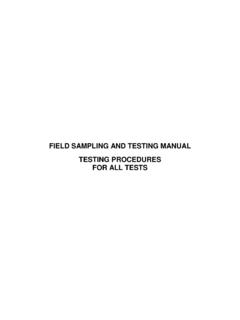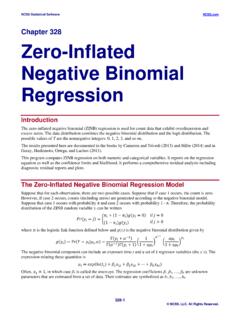Transcription of Chapter 7 SAMPLING PROCEDURES IN RESEARCH
1 123 Scott M. Smith and Gerald S. Albaum, An Introduction to Marketing RESEARCH , 2010 Chapter 7 SAMPLING PROCEDURES IN RESEARCH Researchers must answer many questions when developing a project to collect information about a population of interest. Consider the following questions involving SAMPLING : Should we take a census (complete canvas) or a sample? What kind of sample should be taken? What size should the sample be? Answering these questions depends upon the application of statistical inference. This Chapter first considers the selection of sample types and the process of sample planning. It then describes different kinds of samples. Finally, related to design, but a unique decision area in its own right, is the determination of the size of the sample. PLANNING THE SAMPLE Two broad objectives are fundamental to the use of samples in survey RESEARCH projects: Estimation of information about a population based on a sample from the population, Hypothesis testing to compare the relationships between data items for some selected population groups.
2 Each involves making inferences about a population on the basis of information from a sample. The precision and accuracy of project results are affected by the manner in which the sample has been chosen. However, as Exhibit illustrates, precision is only a reflection of SAMPLING error and confidence limits and has nothing to do with accuracy. Exhibit Precision versus Accuracy in SAMPLING There often is confusion between precision and accuracy in marketing RESEARCH . When a researcher speaks of SAMPLING error and the size of the confidence limits placed on an estimate, that researcher is speaking of precision and not accuracy. Accuracy is affected by nonresponse bias, memory error, misunderstanding of questions, problematic definition of terms, and processing errors, and not by sample size (Semon, 2000).
3 The researcher must constantly ask: Have we asked the right questions? and Have we measured what we want to measure properly and correctly? The difference between precision and accuracy is analogous to the difference between errors of degree and errors of kind. Accuracy, like errors of kind, are clearly more serious. If a researcher has made the correct measurements, precision will show the degree of error; but if the right measurements have not been taken, precision is probably meaningless (Semon, 2000). The quality of a sample depends upon the quality of design and execution of a RESEARCH project at every stage of the process. 124 Scott M. Smith and Gerald S. Albaum, An Introduction to Marketing RESEARCH , 2010 Consequently, strict attention must be paid to the planning of the sample.
4 It must also be recognized that sample planning is only one part of planning the total RESEARCH project. The process of selecting a sample follows the well-defined progression of steps shown in Figure , and will be discussed in turn. Figure Steps in Sample Planning Defining the Population The first step in sample panning is to define the population to be investigated. A population, also known as a universe, is defined as the totality of all units or elements (individuals, households, organizations, etc.) to which one desires to generalize study results. While seemingly an easy task, an imprecise RESEARCH problem definition often leads to an imprecise population definition. Specifying a population involves identifying which elements (in terms of kind) are included, as well as where and when.
5 For example, a group medical practice that is considering expanding into sports medicine might acquire information from any or all of the distinct population groups listed in Table The population element is the unit of analysis, and may be defined as an individual, household, institution, patient visit, and so on. Table Possible Population Choices for a RESEARCH Study by a Medical Practice Group Members Where When All patients Designated group practice Last 12 months Patients who have had orthopedic work Designated group practices Last 12 months All people Specified geographic area Last 12 months All people who have had orthopedic work Specified geographic area Last 12 months The second and third columns of Table define population choices in terms of its location and timeframe.
6 One useful approach is to first define the ideal population to meet study objectives, and then apply practical constraints to ultimately limit and define the study population. However over defining the population should be avoided unless it is absolutely necessary. Over defining can limit the extent to which findings can be generalized, and greatly increase the operational cost and difficulty of finding population elements (Sudman, 1976). 125 Scott M. Smith and Gerald S. Albaum, An Introduction to Marketing RESEARCH , 2010 Census, or Sample? Once the population has been defined, the investigator must decide whether to conduct the survey among all members of the population, or only a sample subset of the population. The desirability and advantages of using a sample rather than a census depend on a variety of factors such as geographic location, the absolute size of the population, and the sample size required for results sufficiently accurate and precise to achieve the required purposes.
7 Two major advantages of using a sample rather than a census are speed and timeliness. A survey based on a sample takes much less time to complete than one based on a census. Frequently, the use of a sample results is a notable economy of time, money and effort, especially when a census requires hiring, training and supervising many people. In other situations, a sample is necessary because of the destructive nature of the measurement, such as in product testing. There is a related problem over surveying human populations when many different surveys need to be conducted on the same population within a relatively short period of time. Nonprobability SAMPLING techniques explicitly protect against this problem. In still other situations, a sample may control non- SAMPLING errors. Samples (a smaller number of interviews compared to a census) may result in better interviewing, higher response rates through more call backs, and better measurement in general.
8 The total amount of SAMPLING and non- SAMPLING error of a sample may actually be than the non- SAMPLING error alone would be for a census. In Chapter 2, we emphasized the importance of minimizing total error. However, under certain conditions a census may be preferable to a sample. When the population is small, the variance in the characteristic being measured is high, the cost of error is high, or the fixed costs of SAMPLING are high, SAMPLING may not be useful. In addition, if the characteristic or attribute of interest occurs rarely in the population, then a census of a tightly defined population might be desirable (for example, people with a rare genetic disorder). In this case, it would be necessary to sample a relatively large proportion of the general population to provide statistically reliable information.
9 Obviously, the practicality of this depends upon the absolute size of the population and the occurrence rate for the characteristic of interest. Sample Design Sample design is the theoretical basis and the practical means by which data are collected so that the characteristics of a population can be inferred with known estimates of error (Survey SAMPLING , Inc.). Operationally, sample design is at the heart of sample planning. Sample design specification, including the method of selecting individual sample members, involves both theoretical and practical considerations (such as cost, time, labor involved, organization). The following checklist is suggested to obtain a sample that represents the target population (Fink, 2003): 1. Are the survey objectives stated precisely? 2. Are the eligibility criteria for survey respondents or experimental subjects clear and definite?
10 Exclusion criteria rule out certain people. 3. Are rigorous SAMPLING methods chosen? This involves selecting an appropriate probability or nonprobability SAMPLING method. 4. Further questions to be answered in this section include: 126 Scott M. Smith and Gerald S. Albaum, An Introduction to Marketing RESEARCH , 2010 What type of sample should be used? What is the appropriate SAMPLING unit? What is the appropriate frame (that is, list of SAMPLING units from which the sample is to be drawn) for the particular design and unit decided upon? How are refusals and nonresponse to be handled? Type of Sample Much of the SAMPLING in the behavioral sciences and in marketing RESEARCH , by its nature, involves samples are selected by the judgment of the investigator, convenience, or other nonprobabilistic (nonrandom) processes.



